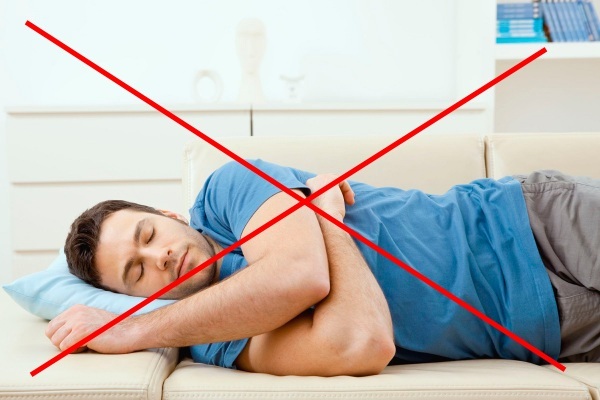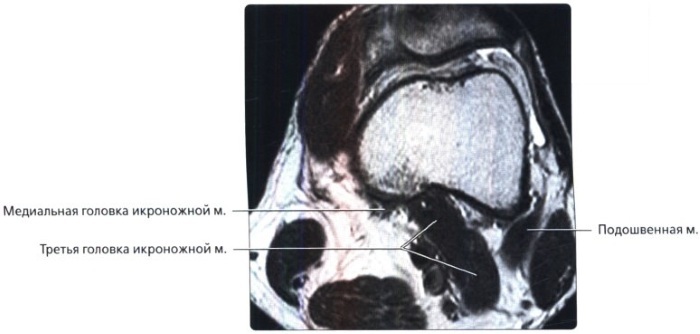The clavicle is a small, S-shaped tubular bone found in humans in the upper limb and connects the arm to the main body. Anatomically, it is the border between the neck and the trunk, connects the scapula to the sternum and strengthens the shoulder girdle.
Record content:
- 1 Functions
- 2 Structure
- 3 Types of diseases
- 4 Symptoms
- 5 Causes of the appearance of diseases
- 6 Diagnostics
- 7 When to see a doctor
- 8 Prevention
-
9 Treatment methods
- 9.1 Medications
- 9.2 Traditional methods
- 9.3 Other methods
- 10 Possible complications
- 11 Clavicle video
Functions
The task of the clavicle is to provide support for the movement of the arms in a free range. Covering the cervical-axillary canal, it protects the neurovascular bundle, veins, arteries and lymph nodes contained in it.
The anatomical location of the clavicle makes it highly vulnerable to injury. No bone on the human body breaks more often than the collarbone.
Structure
The collarbone is located in a person in the upper extremities. This double bone connects to the chest area, shoulder blades and is located above the first rib. The bony structure acts as a brace for the shoulder, helping the person to transfer weight from the upper limbs to the axial skeleton.
The clavicle includes the body and two articular ends, the acromial and the sternal. The body is arched in such a way that the middle part, which is located next to the sternum, has its own bulge, extended forward. And the side part is curved in the rear direction.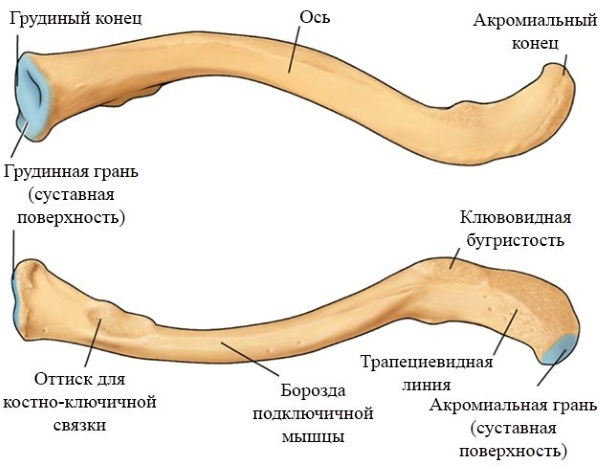
This type of joint is known as a two-plane joint. The two articular cavities are separated by a layer of articular cartilage.
The first joint, the acromial joint, allows the clavicle to slide easily in the shoulder area. The second, the sternum, attaches the clavicle and scapula to the axial skeleton. It also contributes to the creation of a variety of hand movements.
Both joints are surrounded by a cartilage capsule. The upper surface of the clavicle is smooth. Under the collarbone lie the vessels and brachial plexuses that power the hand.
The clavicles, together with the shoulder blades, form a pectoral girdle that attaches the bones of the arm to the torso. The sternoclavicular joints are the only bony connections between the thoracic girdle and the bones of the axial skeleton. The clavicles function as struts, attaching the arms to the torso, allowing the shoulder blades and shoulder joints to move relative to the torso.
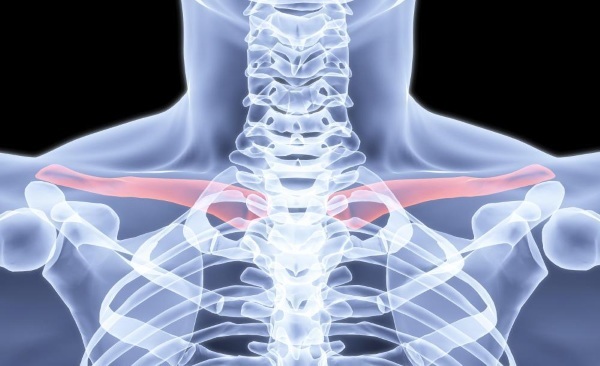
The movement of the clavicles increases the mobility of the shoulder joints as hinges, allowing the arm to move over a wide range. Several muscles in the neck and shoulder are attached to the clavicle, including the pectoralis major, sternocleidomastoid, trapezius, and deltoid.
The male is somewhat different from the female clavicle. It is more elongated because men have more muscle tension.
Types of diseases
The collarbone is located in a person in a place that is at frequent risk of injury. Violations are caused by both mechanical and internal causes. The reasons for the appearance of pain can be: fracture, arthritis, bone infections and other conditions.
Complications associated with developmental defects, heredity:
- Congenital false joint of the clavicle. Typical deformities are shortening, thickening, and the appearance of a pseudarthrosis in the distal middle third of the bone structure.
- Holt's Syndrome. This is a syndrome of hereditary multiple malformations of the child, including the scapula, collarbones, and skull bones.
- Clavicular-cranial dysostosis. An inherited disorder caused by a gene mutation. In this case, defects in the development of the skull, partial or complete absence of clavicles are observed.
- Congenital deformities of the clavicles. Rare occurrences include the costoclavicular joint, split collarbone, perforated. The latter anomaly involves a bony structure that has holes in its body. Congenital abnormal structures undergo subsequent bone grafting if they disrupt the functional activity of the clavicle.
Mechanical damage to the clavicle includes:
-
Fracture. If a person falls heavily on one shoulder with an outstretched arm, then he risks getting a fracture of the clavicular bone.

- Dislocation. The symptoms of the dislocation can be mild or severe. In uncomplicated dislocations, slight damage to the ligaments occurs. Moderate cases may include completely torn ligaments with significant dislocation.
Internal causes affecting painful changes in the clavicle:
- Osteoarthritis. The wear of the acromioclavicular joint is the abrasion of the articular cartilage. The disease can be the result of an old injury or increased stress on the joint for many years.
- Thoracic outlet syndrome. The space between the collarbone and the first rib is filled with blood vessels, nerves, and muscles. Sensitivity and blood supply in this area is sometimes impaired by the compression of nerves and blood vessels. The weakened shoulder muscles allow the collarbone to slide downward, putting pressure on the nerves and blood vessels in the thoracic region. Pain in this area can occur without damaging the bone.
- Osteomyelitis. In medical practice, postoperative osteomyelitis is more common, which sometimes develops after the operation of osteosynthesis with the use of metal structures in patients with fracture of tubular bones. In some cases, the development of the disease is associated with a purulent-necrotic process that develops in the tubular bone.
- Crayfish. Malignant tumor or Young's sarcoma, affects the tubular bones, which include the clavicle.
An uncomfortable sleeping position can lead to pain in the collarbone. The habit of sleeping on one side puts pressure on the joint, leading to long-term discomfort.
Symptoms
In humans, the most obvious symptom of a fracture is sudden, sharp pain where the collarbone is located. The pain intensifies when moving the shoulder, at times a crunch is felt inside the bone.
Other signs of a broken collarbone include:
- swelling at the rupture site;
- external hematomas;
- pain when touching;
- stiffness in the affected arm.
Newborns with a broken collarbone lose the mobility of their injured arm for several days after birth. Signs of osteoarthritis include pain and stiffness in the affected joint, which tend to develop slowly and gradually and get worse over time. The manifestation of thoracic outlet syndrome depends on which nerves or blood vessels are affected by the displaced clavicle.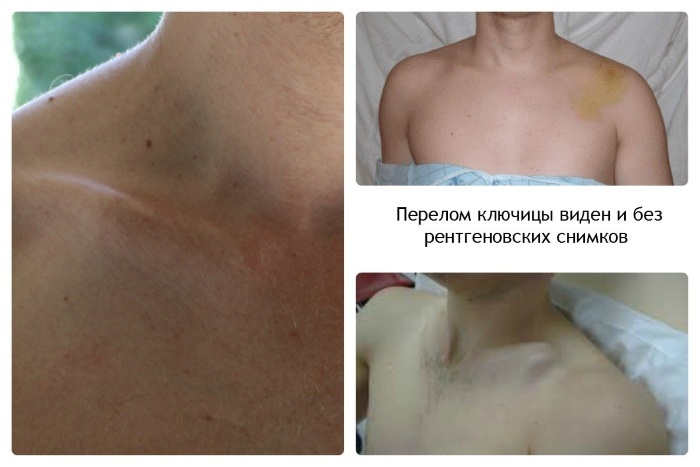
Some of the symptoms include:
- pain in the collarbone, shoulder, neck, or arm;
- wasting muscles in the main phalanx of the thumb;
- tingling or numbness in your hand or fingers;
- weakened grip;
- arm pain or swelling;
- discoloration of the hand or finger;
- weakening of the muscles of the upper limbs and neck;
- a painful lump in the collarbone.
The symptoms of osteomyelitis are:
- swelling and fever around the infected area;
- high overall temperature;
- nausea;
- suppuration around the wound.
Causes of the appearance of diseases
Clavicle fractures occur under the following circumstances:
- Sports injuries. Direct hit in the shoulder in contact sports, participation in "extreme" sports where falls are possible, such as cycling and skateboarding.
- Fall on shoulder or outstretched arm.
- A car accident that injures the shoulder, sternum, or both.
- Fracture at birth. A newborn's collarbone may break as it moves down the birth canal.
Causes of the thoracic outlet syndrome:
- shoulder injury;
- poor posture;
- movements of the same type, such as repetitive weight lifting or swimming;
- obesity, which puts pressure on all joints;
Factors affecting the development of osteomyelitis:
- rupture in case of injury, when the end of the collarbone pierces the skin;
- pneumonia, sepsis, or another type of bacterial infection elsewhere in the body that gets into the collarbone;
- an open, infected wound near the collarbone.
Diagnostics
During the physical examination, there is a drooping shoulder on the affected side, edema and hematoma in the middle third of the collarbone. Often, the elements of a fracture can be felt by probing the site of the lesion. In case of injury at the site of the fracture, there is a clear deformation or "bulge".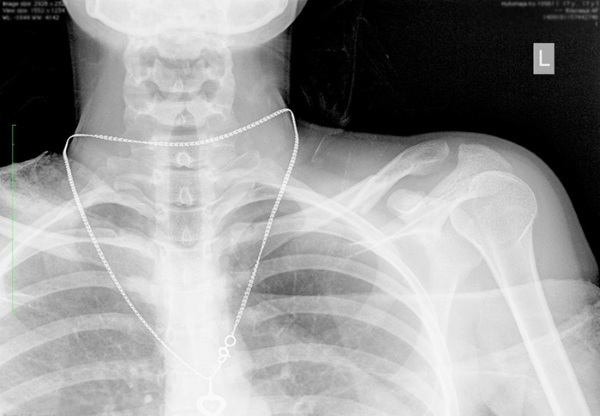
Light pressure on the tear site causes pain. The physician must ensure that no fragments of the fracture have penetrated the skin and that there is no obvious damage to blood vessels or nerves.
A physical examination is followed by a diagnostic test. For this, an x-ray is taken, after which the final diagnosis is made and the optimal form of treatment is determined. After treatment, CT is done to assess the healing of the injury.
When to see a doctor
A person's collarbone is located in a place where pain can affect most of the back. If the discomfort lasts more than a day and the symptoms worsen, you should see a doctor.
For an injury that causes a visible change in the position of the collarbone or shoulder, the person should receive emergency medical attention. Delaying seeking help complicates the healing process.
In the clinic, you should visit a surgeon who will determine the cause of the disease after taking an X-ray. If, in addition to pain, there are other unexplained symptoms, you should be examined by doctors of narrow specialization.
Prevention
Because a collarbone fracture occurs suddenly, it is difficult to prevent it.
But you can reduce the risk of:
- Recommended protective equipment should be worn when playing contact sports.
- Maintain bone health. This is possible if you follow a balanced diet that includes fruits, vegetables, foods rich in calcium and vitamin D.
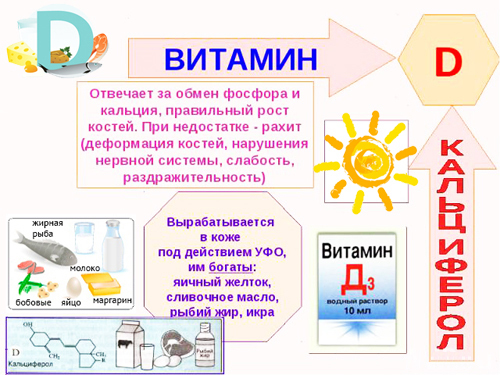
- Engage in strength training and stretching exercises to build strong, flexible muscles. They will help support bones, make the body flexible, able to survive a heavy fall with less loss. A proper warm-up, including dynamic stretching exercises, will help your muscles work better and more correctly.
- Wear suitable footwear when playing sports.
Treatment methods
Treatment depends on the severity of the injury. If the fracture is not displaced, further healing takes place on its own. In this case, the hand should be immobilized and placed in the sling. The clavicle is in a person's mobile place, but bone structures usually grow together without immobilization, even when the fragments are displaced.
Surgical intervention is carried out in the following cases:
- open fractures;
- damage in which the nerves are affected, the neck of the scapula;
- fractures with significant displacement of fragments;
- fractures with the threat of perforation of the skin by clavicular fragments.
Mild pain caused by muscle strain, minor injury, can be treated at home:
- Applying ice to the damaged area every four hours.
- Applying a special bandage or staple.
- Removal of puffiness. To do this, you should remain immobile in the area of damage for 24 hours. You should sleep with your head and shoulders slightly raised.
- Avoid activities that will even slightly strain your shoulder.
The first line of treatment for thoracic outlet syndrome is physical therapy. The patient is taught exercises that develop posture, flexibility of the shoulder muscles. This is done to relieve pressure on blood vessels and nerves.
In more serious cases, surgery is performed to remove part of the rib and widen the chest opening. In some cases, surgery is performed to repair damaged blood vessels.
Cancers that develop in the collarbone, shoulder, or arm are treated with radiation therapy or surgery, depending on the type of disease and the degree of progression.
Treatment of osteomyelitis begins with antibiotics given intravenously in a hospital setting. Further medication may last for several months. Pus or fluid at the site of infection is also removed in a hospital setting. The affected shoulder may be immobilized for several weeks while it heals.
Medications
In most cases, mechanical types of injuries, other disorders of the clavicle are subject to conservative treatment with drugs.
| Drugs | Mechanism of action | Appointments | Prices |
NSAIDs that relieve osteoarthritis pain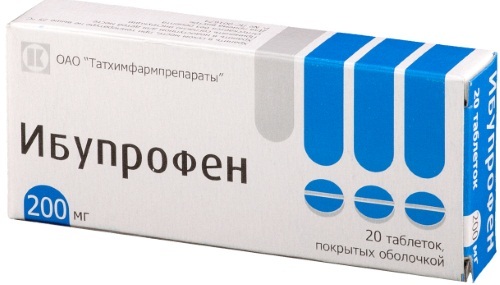 | |||
| Ibuprofen | Effective for pain accompanying inflammation, eliminates stiffness, swelling | Arthritis, osteoarthritis, neuralgia, traumatic tissue inflammation | 35 RUB |
| Nalgezin | Relieves pain, swelling, joint stiffness | Joint pain | RUB 250 |
| Meloxicam | A drug from the oxicam group, with an analgesic effect | Arthrosis, arthritis of various etiologies | RUB 80 |
| Pain relievers | |||
| Nise | Relieves pain syndrome, inflammation | Neuralgia, myalgia, arthralgia, osteoarthritis | 220 RUB |
| Voltaren | The drug based on diclofenac relieves pain, inflammation | 120 RUB | |
| Askofen | Pain reliever, dilates blood vessels, relaxes skeletal muscles | It is used for infectious and inflammatory diseases, arthralgia, neuralgia. | 120 RUB |
| Ibuklin | Analgesic anti-inflammatory drug | For pains of various etiologies | RUB 150 |
Corticosteroids that relieve inflammation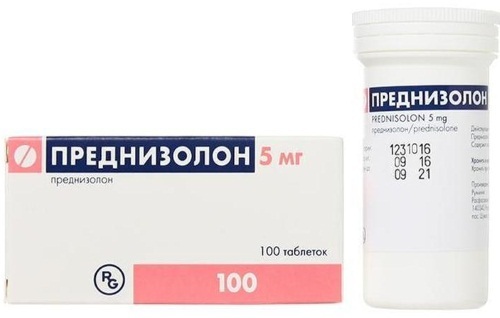 | |||
| Prednisolone | Synthetic hormone suppresses inflammatory responses | Joint inflammation | RUB 50 |
| Dexamed | Synthetic glucocorticoid, anti-inflammatory | Rheumatic diseases, malignant neoplasms in the form of lymphomas | From 150 rubles. |
Among the medicines that help relieve pain in the clavicle, topical ointments and gels are in the first place.
Preparations containing NSAIDs:
-
Fastum-gel, Fast-gel, Ketonal - gels and ointment based on ketoprofen. They act as analgesics, anti-inflammatory drugs, and are used in the treatment of joint and muscle injuries.
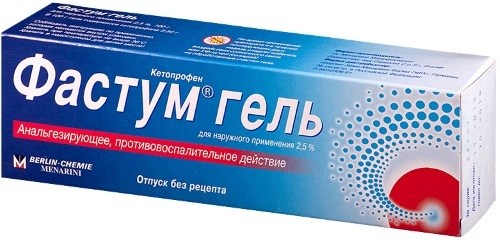
- Diklovit - a product based on diclofenac. It is a good pain reliever, relieves swelling, and helps to increase joint mobility. The ointment is used for bruises, arthralgia, myalgia caused by heavy exertion.
- Nurofen - ibuprofen ointment. The drug penetrates well under the skin, tendons, fascia. It is used for injuries of the musculoskeletal system.
Combined drugs:
- Finalgon. The active ingredient of the ointment is nicoboxil. The drug stimulates local blood circulation, is used for joint pain, bruises, local injuries.
- Apizartron. Bee venom ointment, activates metabolism, reduces muscle tone, reduces pain. It is used for arthritis, arthrosis, bruises.
- Dolobene. Ointment based on sodium heparin. It is used for bruises, hematomas, limited mobility. Promotes tissue regeneration, effective for local anesthesia.
Plant-based massage balms:
- Sofia cream with bischofite. The drug enhances blood circulation, has a good effect on the musculoskeletal system, increases mobility.
- Doctor Theiss (Comfrey). The ointment is used for bruises, joint injuries, has a good analgesic effect.
Traditional methods
Herbal decoctions are useful to strengthen the skeletal system.
Ingredients for Recipe # 1:
- 4 tbsp. l. field horsetail.
- 3 tbsp. l. comfrey medicinal.
- 2 tbsp. l. oats.
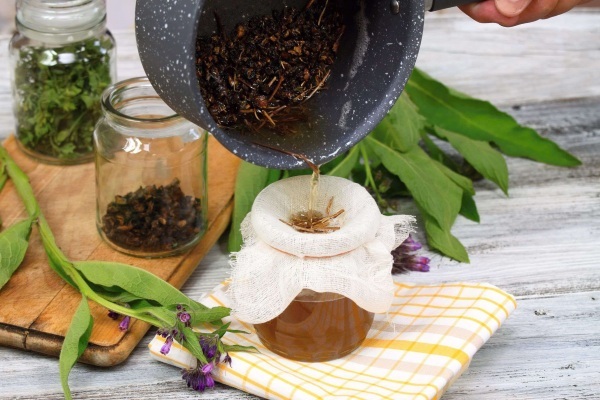
Ingredients for Recipe # 2:
- 3 parts rose hips.
- 2 parts dry nettle leaves.
- 2 parts dry raspberry leaves.
- 1 part horsetail.
How to make a decoction:
- Mix the herbs and place in a glass jar.
- Pour boiled water, filling the jar not to the very top. Cover and leave for 12 hours.
- Strain the tincture, add a little honey if desired.
- Take 250 ml daily twice a day.
To strengthen the bone and cartilaginous system, it is useful to take broths prepared on the basis of bones, dishes in which gelatin and agar-agar are added.
Other methods
The collarbone is located in a person in such a place that in case of injury, the function of the entire upper limb is disrupted. Therefore, the main task in restoring a joint is to reliably limit the mobility of the shoulder girdle.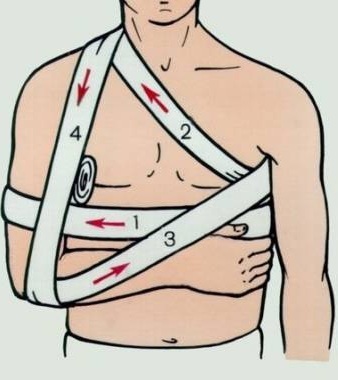
For minor fractures, a Dezo bandage is used. It firmly fixes the shoulder, does not allow it to move voluntarily. The fixation bandage is used not only for treatment, but also after surgery.
For a complex fracture, Delbe's rings are used. An orthopedic corrector consists of belts threaded through rings that cross over the shoulder blades.
The bandage securely fixes the collarbone in the correct position.
In the presence of complex injuries, when it is necessary to solve the problem of fusion of bone structures, a surgical method is used. Osteosynthesis is an operation that allows you to connect the deformed bones of the clavicle using metal structures. After the initial period of rehabilitation, physiotherapy is prescribed to patients.
Sessions are held:
- magnetotherapy;
- ultrasonic;
- high-frequency therapy.
Possible complications
Most broken collarbones heal without difficulty.
Complications, when they occur, can include:
- Injury to a nerve or blood vessel. The jagged ends of a broken bone can damage nearby nerves and blood vessels. If you feel numbness and coldness in your hand, you should see a doctor immediately.
- Poor or delayed healing. Poor bone connection during healing can shorten the bone, leading to deformity of the shoulder.
- The appearance of a bone build-up. It forms a lump of bone at the place where the bones join. It is easy to see because it is close to the skin. Most of them disappear over time, but some remain forever.
- Fracture, in which the joints connecting the clavicle to the scapula or sternum are involved may increase the risk of developing arthritis in that joint.
Health problems that can contribute to a non-healing clavicle include diabetes and smoking. The elderly also tend to have slow bone healing.
Musculoskeletal problems arise not only in the clavicle, but also in other bone structures in the human body. It can be very easy to damage the bone, and it takes a lot of time and effort to recover and rehabilitate. Therefore, health care is an integral part of a fulfilling life.
Author: Belyaeva Anna
Clavicle video
Clavicle Anatomy:

